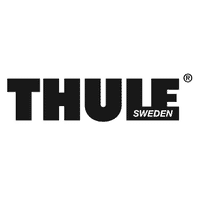Everything you want to know about Mountain Bikes
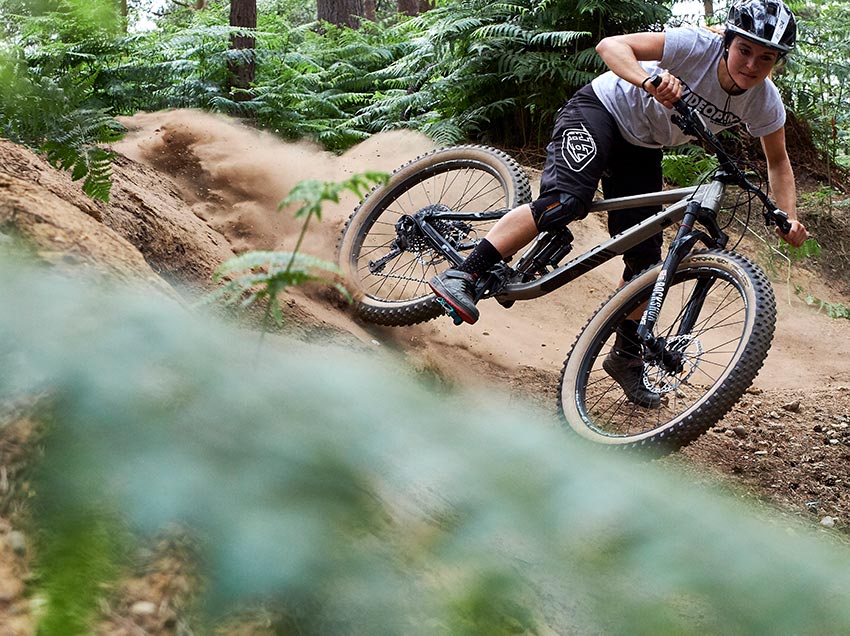
Buying your first mountain bike can be confusing. There will be a lot of words thrown around that you might have never heard before. It can intimidating to ask what they mean. To help you out, we’ve created a guide so you know what to look for in a mountain bike, and we’ll break down the jargon as we go.
Groupset 101
You’ll hear people talk about what groupset is on their bike, and understanding what they mean can be confusing. One of the reasons that groupsets confuse people is that what is included in a groupset has changed over time. It used to contain almost every part that was not the frame, back when road bikes ruled the roost.
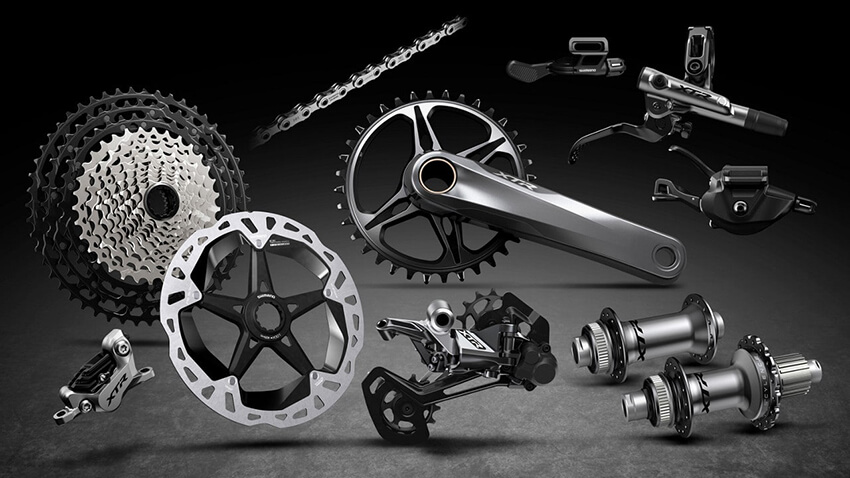
Shimano XTR Groupset
The modern mountain bike idea of a groupset is a collection of components that make up a bike’s drivetrain; sometimes brakes are included. Your mountain bike groupset will then comprise of
Parts of a Drivetrain
- Shifters
- Front Derailleur
- Rear Derailleur
- Cassette
- Chainset
- Chain
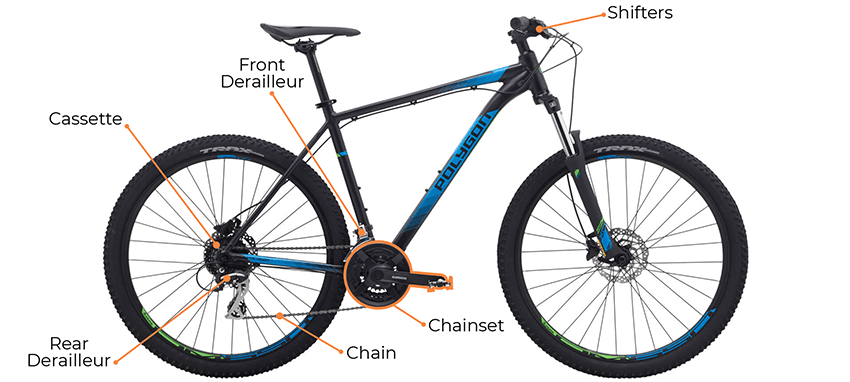
Groupset hierarchies
The two main mountain bike groupset suppliers, SRAM and Shimano, supply parts of a similar level in each groupset. You can then go up or down in levels of quality. With each jump up the groupset hierarchy, you’ll find that groupsets get lighter, they use better quality materials, and they tend to look more aesthetically pleasing.
You’ll also find that higher-end groupsets bring you more gear choices. Shimano XTR will offer you a 12-speed cassette, while Shimano Alivio will offer you a 9-speed cassette. It might seem a small difference to have three extra cogs, but when you’re riding uphill and close to giving up, it can be a small relief to know that you still have even one more cog you can shift down onto and carry on going.
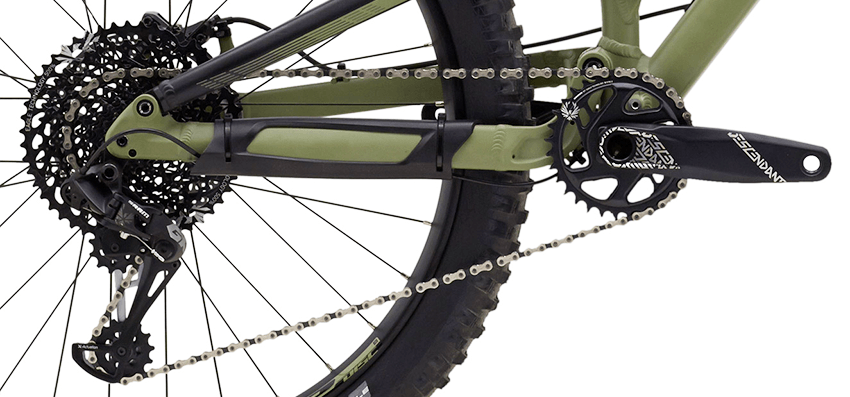
SRAM GX Eagle on the Polygon Siskiu N9
It is also worth knowing that on that very same hill, you’ll find it easier to change gear on the higher level of groupsets. When you’re on your last legs it can be a struggle to change gear, and you’ll get that lovely sound of a chain trying to move but only rubbing between two cogs. It can be the last straw. On higher groupsets you can change, even when the drivetrain is under load, and carry on.
That is simply why it is worth the money to buy the best groupset you can. Below, we’ll list the groupsets from highest to lowest.
Shimano Hierarchy
|
HIGH-END ENTRY-LEVEL
|
XTR |
| Deore XT |
|
| SLX | |
| Deore | |
| Alivio | |
| Acera | |
| Altus | |
| Tourney |
Shimano also has two groupsets for those of us that just want to go downhill fast.
| Saint |
| Zee |
SRAM Hierarchy
|
HIGH-END ENTRY-LEVEL
|
XX1 |
| X01 | |
| X1 | |
| EX1 | |
| GX | |
| NX | |
| XX | |
| X0 | |
| X9 | |
| X7 | |
| X5 | |
| X4 | |
| X3 |
SRAM also has a downhill specific groupset
| X01 DH |
Which groupset do I need?
There is a point in each groupset where for the majority of people you reach a quality/price ratio that works. For instance, many people will happily always use Shimano Deore or SLX, and never consider the extra cost of XTR to be worth it as they aren’t racing and don’t need a super light bike.
For the people that prefer SRAM’s shifting they tend to find that same point at X1, as it is the point you get the majority of the benefits of the higher groupsets but also keep some money in your wallet.

Getting charged
Both SRAM and Shimano now offer electronic shifting in their higher groupset offerings. As you might be able to guess these are not cheap. They do offer the advantage of changing instantaneously, and you’ll have a lot less maintenance and fine-tunning to do.
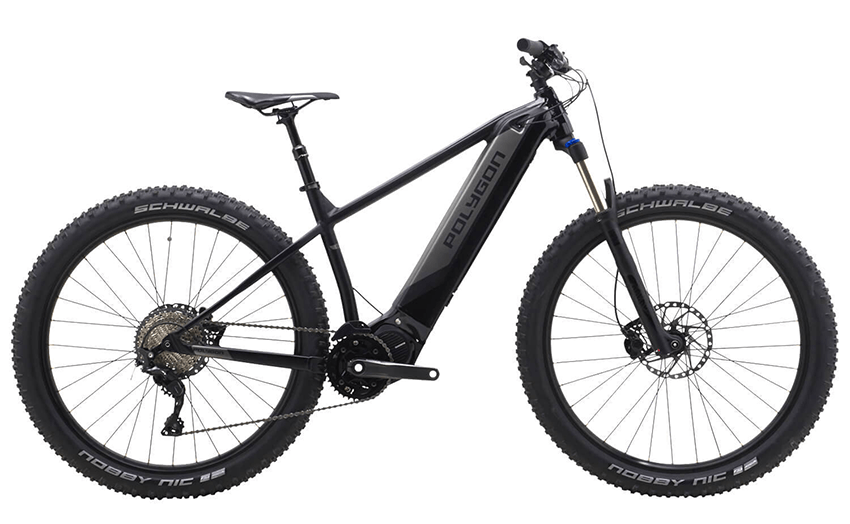
Suspension
One of the defining features of a mountain bike is that they come with suspension. It’s usually the main reason you buy a mountain bike. You’ll find a bike with just front suspension, hardtails, or bike’s with both front and rear suspension, full suspension.
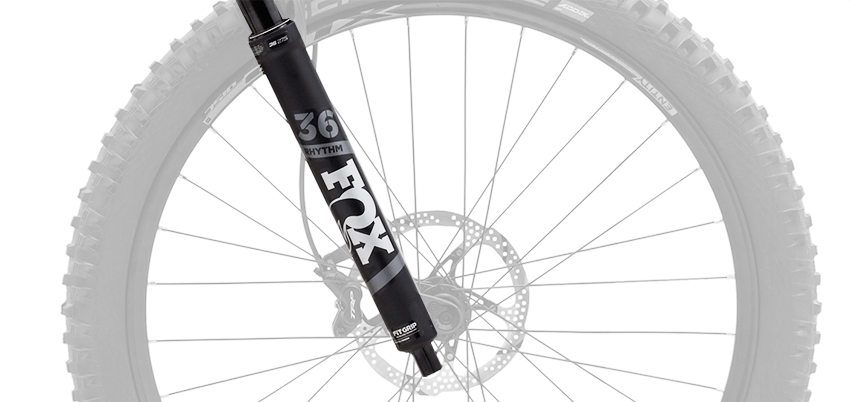
Fox 36 Rhythm front suspension on the Polygon Siskiu N9
Like groupsets, suspension forks come in hierarchies. Unlike groupsets, these can be a bit blurred and lines may be crossed. Generally, you’ll find that cheaper bikes have SR Suntour, the next level up is RockShox, and then manufacturers will go with Fox. You’ll also be able to find bikes with X-Fusion, Manitou, and Marzocchi offerings, but these are less common.
The way we have written above it would seem like Fox sits above RockShox, but that isn’t always the case. It is just that RockShox offers cheaper forks, and then has forks that sit alongside Fox. The reason for the overlap has to do with coil or air springs.
Fox doesn’t do coil springs; all their suspension forks are air sprung. Air sprung forks are more expensive than coil sprung forks and crucially lighter. The cheaper SR Suntour and RockShox forks are coil sprung.
What is the difference between air and coil springs?
Like everything in life, there are pros and cons to air or coil forks. Air forks will need more servicing but will be a lot lighter. Coil forks will be heavier, but you’ll get the same feel no matter where you ride them. For instance, you’ll find that coil forks will feel the same in summer weather at low levels as it will in the mountains in winter.
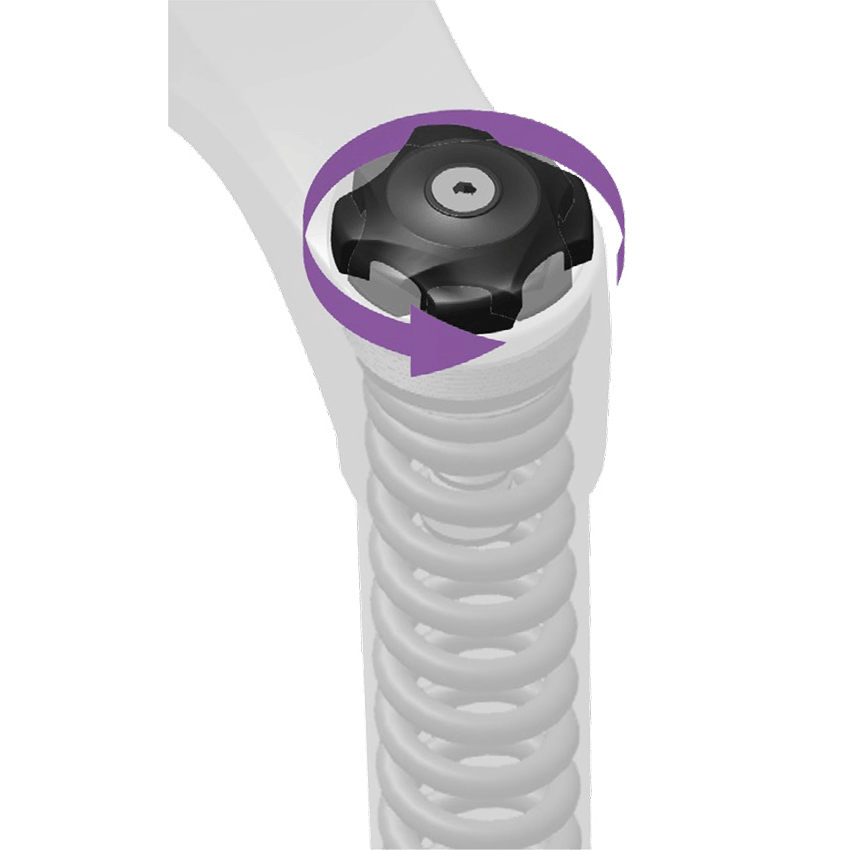
Coil suspension fork
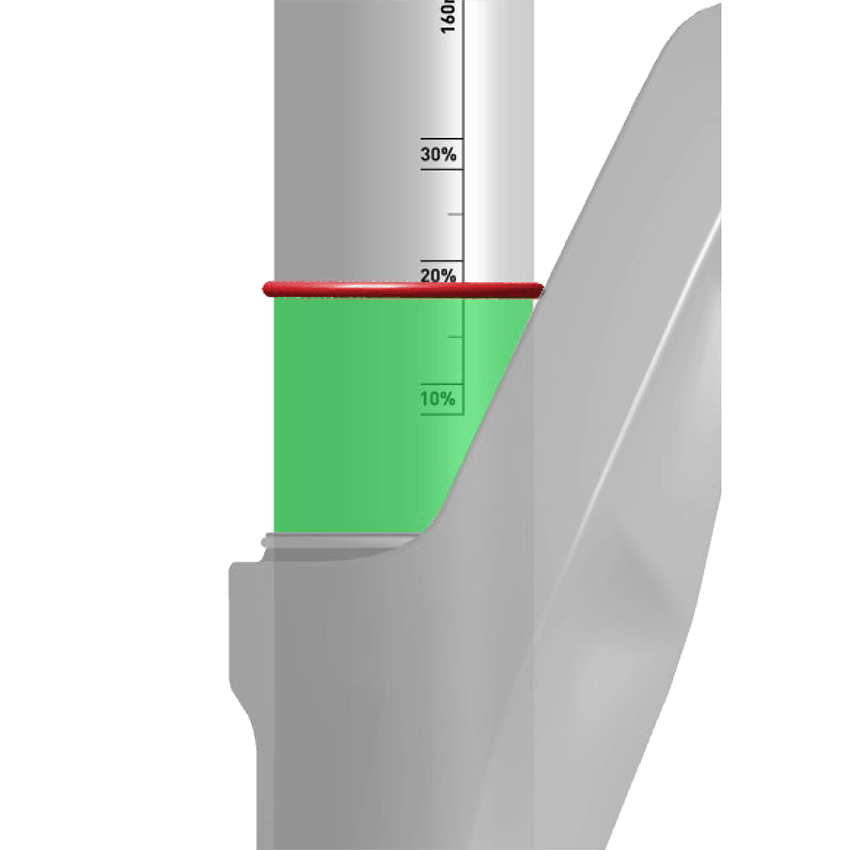
Air suspension fork
The big difference between air and coil forks is how they feel. A coil fork will feel more linear and an air fork will feel more progressive as they go through their travel. The next big difference is that you can easily tune your air fork to suit your riding style and your weight. With a coil fork, you need to buy an entirely new spring and fit it; the cost may be prohibitive on the cheaper forks when doing this.
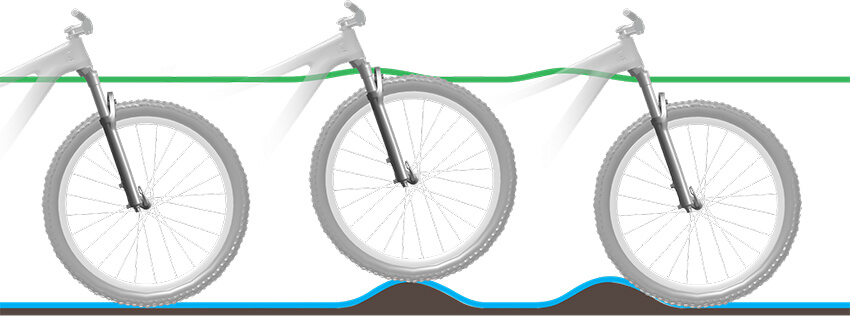
You’ll also find that on cheaper SR Suntour coil forks they use a plastic shim to stiffen the suspension. The plastic shim will eventually stop working, and you’ll have a less stiff fork, at which point you might find it easier to buy a new fork, rather than service a fork. That is why it makes sense to buy a slightly higher priced mountain bike; you’ll save yourself more money in the long run.
Wheels
Wheels used to be simple in mountain biking. You got 26” wheels that had a 100mm quick release axle at the front and a 135mm quick release axle at the back. Now you have 27.5” or 29” wheels. You have Boost wheels and thru axles, and what does that mean? Well, it can all get a bit confusing.
What we can say is you don’t want to buy a mountain bike with 26” wheels, unless it’s a dirt jump bike. We are starting to see 26” parts slowly disappear. If you’re planning on upgrading your bike in the future, you don’t want to buy a bike with the standard 9mm quick release levers. You’ll be looking for a bike with thru axles, or you’ll be having issues in the not too distant future. Thru axles are axles that go through the centre of your hub body and then screw into your frame or fork.
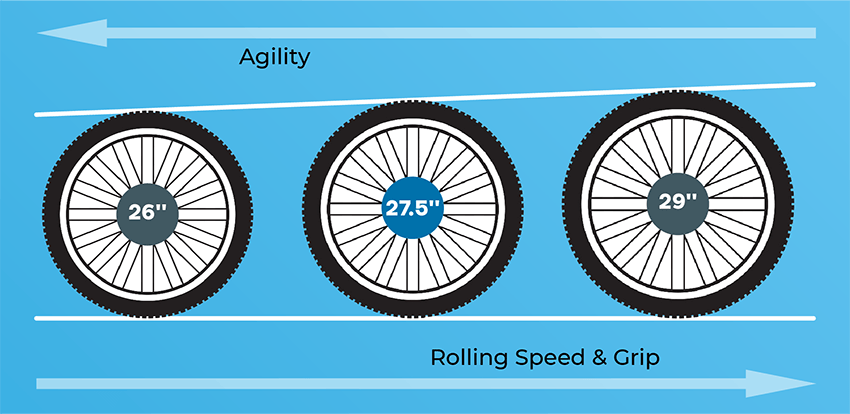
What you need to decide on is whether you prefer 29” wheels or 27.5” (650b) wheels. There is a simple rule that people use here, but feel free to break it. Generally, if you're smaller, 27.5” wheels will suit you better, especially if you want a playful bike. 29” wheels will work better for larger sized people.
29” wheels will also work better on a bike that you want to be fast. If you want to race XC, a 29er will be your most logical choice. If you want to play about the trail centre and hit a few jumps a 650b bike will maybe suit you better. As with everything though there are great XC 27.5” wheeled bikes, and there are great 29” trail bikes.
Axles
As we mentioned, you’ll be wanting thru axles to help future-proof your bike. You’ll find that generally means a 100 x 15mm on the front, and 142 x 12mm on the rear. These are a small evolution of the quick release standard that was found on your 26” wheeled mountain bike.
These thru axles allowed you to have stiffer wheels, and wheels that worked more efficiently with higher powered hydraulic brakes. These worked well on 26” wheels but then we went up wheel sizes and found that our wheels weren’t as stiff.
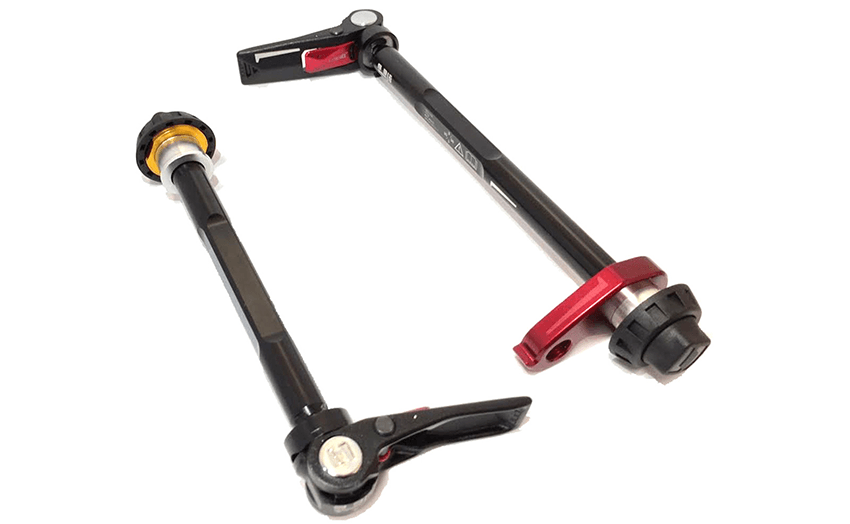
Nalid Thru Axle

Polygon 2HRU Rear Quick Release Skewer
Larger wheels allow us to roll over obstacles on the trail easily so increasing the size of your front wheel makes sense. With larger wheels, the spoke angle wasn’t quite as good so you step forward to Boost. Boost did more than make the axle on your bike longer.
You’ll find the the front axle went from 100mm to 110mm and the rear axle went from 142mm to 148mm. What this did was allow wheel manufacturers to build wider hubs with their flanges further apart. The wider hub flanges changed the spoke angles on the bigger wheels. The new angle allowed wheels to be built strongly and stiffly, something we can all benefit from on the trail and it seems to be the direction where most manufacturers are going and is a good way to make sure your bike is future-proofed.
In the end:
So there you have it, armed with this information you are clear to surf the web and find a bike that fits your needs and your wallet. Be sure to check the Mountain Bikes on offer at Bicycles Online before you check other brands online or in a shop. We offer a free 14 day test ride on all our bikes and ship all over Australia. You also have access to full spec lists on each bike and unbiased comparisons with other bike brands.
If you have any questions, feel free to call, email, or live chat with our customer service team.

 AUS
AUS USA
USA




.jpg)











